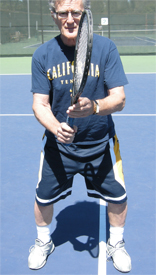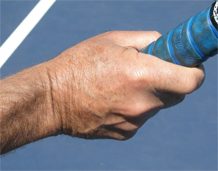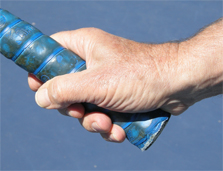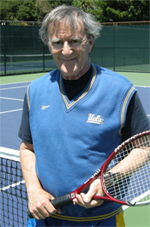The Classic
Forehand Volley
Paul Cohen
If you read Jeff Greenwald's article last month (Click Here) on incorporating attack into his game, what he says is true. I am the coach who told one the top senior players in the world that he was playing some of dumbest tennis I'd ever seen.
As Jeff explains, that meeting was the start of a collaboration that led to major changes in his game, something that was unusual impressive for such an accomplished player.
Basically, Jeff learned to use his formidable baseline weapons to set up opportunity attacks, close the net, and win many points with relatively easy volleys. As he explains in his article, these changes were critical in winning a world seniors championship.
All credit goes to Jeff, but I was honored to be a resource for him in this process. In this article I want to explain the basic work we did together to improve his technique on the forehand volley, technique that is ideal for players at any level. Then in a subsequent article we will look at the backhand volley as well.
History of the Volley
The reality is that the volley is currently a vanishing shot at every level of the game of tennis. Roger Federer beat Pete Sampras, his idol and role model, in a 5-set serve and volley match at Wimbledon in 1999. Fast forward 13 years to this year's Wimbledon and Federer defeated Andy Murray playing primarily from the baseline, as he has for most of his incredible career.
Today's Modern Game is the Great Groundstroke Era. The Great Volley Era was from the 1940s through the 1990s.
History's best volleyers included players like Jack Kramer, Pancho Gonzalez, Lew Hoad, Ken Rosewall, Tony Trabert, Rod Laver, Frank Sedgeman, and Roy Emerson. There there were players like John Newcombe, Tony Roche, and Fred Stolle.
Finally we saw John McEnroe, Stephan Edberg, Boris Becker, and Pete Sampras. These players represented the end of an era.
There is little argument that today's modern tennis players have the best groundstrokes in the history of the sport. But the players of the Gonzalez generation were the best volleyers.
Today's volley quality is well below that level. Today's players certainly have the talent to raise their technique and volley as well as anyone, past or present.
But statistics prove that they just don't do it in matches. The volley in this generation has atrophied because the modern game is primarily a backcourt slugfest.
In pro tennis, the best volleyers play doubles, not singles. Because Federer, Nadal, Djokovic, Murray and most of the big names do not play regular doubles, their volley skill, feel and control has not developed with the rest of their games. They are good volleyers, not great volleyers.
Consider this: in a Federer versus Nadal three set match, each player might come to the net 5-10 times. And then usually, they will hit only one volley before the point ends one way or another, often with a huge topspin pass.
First volley short volleys and touch angles are rarely seen. Second volleys hardly exist.
Forehand Volley Flaws
Most pro players today have fairly good backhand volleys. But few have great forehand volleys. This is because the forehand volley is the more difficult to hit.
Most backhand volleys are hit early, well in front of a player. But if you watch closely, you will see the contact points on the forehand volley today are hit slightly late.
This is related to the use of the hands in the preparation. Rather than pushing forward together, they separate too soon, as we will see.
We do not see players battling at the net, hitting multiple volleys. These battles belong to the Gonzalez generation. They were beautiful.
But today's big baseline and midcourt groundstrokes and heavily spun passing shots are more powerful than any volley. This is a shame because attacking points finished at the net are far more dramatic than numbing, 30 ball baseline exchanges.
Classic Forehand Volley


There are actually several types of forehand volleys. But in this article I want to explain the one I prefer and the one that I presented when I worked with Jeff.
This is the classic forehand volley, or what I sometimes call the low volley--not because of a low contact position, but because of the way players use their bodies and legs.
I prefer using the legs as much as possible on the forehand volley, hitting the ball well in front of you, and keeping the wrist laid back about 45 degrees.
Imagine that you are a catcher in baseball, squatting down, reaching for the incoming pitch with both hands. Now, stand up but still bend your knees. This use of the legs is one of the factors really missing from the modern pro volley.
The other key factor is the use of the hands. I call my preferred technique a "two handed volley," but I don't mean players should make contact with both hands on the racket.
A two-handed forehand volley means that both hands reach forward to position the racket head behind the ball. This is critical to create early contact.
I believe this technique is not only more effective, it is easier for all levels of tennis players including touring pros. It forces you to move to the ball, weight forward, with your eyes closer to the flight of the incoming shot.
To feel how this works, without your racket, have someone throw a tennis ball to you underhanded. You will naturally reach with both hands.
Note that your right hand catching the ball has your wrist bent back about 45 degrees. Notice how your hand and fingers naturally squeeze the ball when you catch it. This is same feel you want for a high quality forehand volley.
The Progression
Start with the ready position, which is the same for the forehand and backhand volleys. Hold the racket with a Continental grip. The body position is "low" with the knees bent, and the back and shoulders slightly sloped forward.
If you are just learning, or have a poor forehand volley, grip the racket in the Eastern Forehand grip. As you learn the shot, you will gradually change to the Continental grip.
Your preparation is simultaneously with your feet and your hands. The step is forward and somewhat to the side with the right foot.


Simultaneously as you step reach to the incoming ball with two hands. This two handed move is the critical key to early contact.
Your racket head will be placed about 2 feet in front of your right shoulder. Your wrist should be laid back at least in a 45 degree angle, palm pointing towards your opponent.
Your body is now completely behind the shot. Your eyes are focused at the incoming ball level. See the ball in front of your body position, almost as if you are looking through the racket strings at an incoming ball.
The idea is to get your head, eyes and body down close to the flight of the ball. If the ball's plane is higher, your body will naturally straighten up.
Now step forward with your left foot. Your strike is a short downward, angled punch, leading with the bottom edge of the racket, stopping at contact point.
Squeeze the racket handle at contact point with a strong grip, mostly with your last three fingers. Stop your racket head at contact point for control, power and backspin. Once the ball is hit well in front of your body, you see the shot perfectly with both eyes.
The art of the strike is to feel the "play" of your racket head and hand on the downward 45 degree angle strike, yet at the same time, being firm at the contact point.
Do not guide your volleys with long finishes unless the oncoming ball is very slow. Your squeezed grip feel will have a bit more pressure on your last three fingers, not your thumb and first finger.
Do not lean forward in your recovery position. Recover to the ready position and keep your feet moving! Be ready for any reply, especially a lob.
Wide, low and reaching balls cannot be hit as far in front of you as a straight incoming ball. These struggling balls are contacted naturally with less wrist laid back.
You will be fighting for your life on these shots. Keep your head held through contact point for a split second and keep a firm grip, beveling your racket head as you undercut/slice your low, wide and reaching shot.
High balls are more natural shots. Most are easy to hit in front of you. If the ball is slow and floating, take a bolo punch long stroke, wrist laid back, soft hand, semi full natural full swing, level off your hitting plane and whack your shot.
A first angle soft touch volley is almost extinct. John McEnroe's angle volleys, first and second were the best in the history of the sport. Hook your wrist, watch the ball carefully, keep your grip and hands soft and catch the outside edge of the ball.
This shot is tremendously effective for a player like Jeff who can hurt his opponent with a heavy forehand approach, close fairly tightly to the net, and then angle the ball crosscourt on a sharp angle for a winner.
Besides the basic work on his technique, this short angle was key volley we developed with Jeff, also working with Rod Heckelman on this shot and the short angled overhead. (Click Here to read Rod's article on the drills he did with Jeff that were critical for him in mastering the transition and attacking game.)
Post Script
Many years ago our brain trust of Instruction Editors at World Tennis Magazine--then the leading voice in the sport--met in New York City to discuss the next year's instruction program.
The subject of the forehand volley came up. Both Fred Stolle and Cliff Drysdale demonstrated a firm somewhat straight wrist, chop down punch forehand volley, not hit very much in the front of the body.
Then I demonstrated the low body position contact in front, 45 degree angle forehand volley just described. Jack Kramer didn't say a word. Jack just put up his hand about two feet in front of his right shoulder, laid the wrist back 45 degrees and punched leading with the bottom edge of his hand. Enough said.




